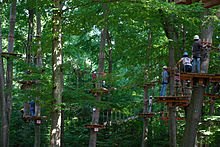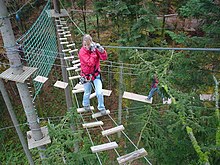Rope course
A rope garden (also rope park in Switzerland ) consists of several masts or trees that are connected by various elements (rope bridges, beams, etc.).
If the ropes are at a height that makes it necessary to secure the participant, one speaks of a high ropes course . In low ropes courses , the ropes are attached at jump height (usually less than one meter). If the elements are installed between trees, this is called a forest ropes course or climbing forest . In some cases, rope courses are called climbing courses. However, in rope courses it is less about climbing technique than about a head for heights and overcoming your own fears.
Rope gardens can be set up stationary as a permanent installation, mobile (transportable) or temporarily (short-term rope structures). Mobile and temporary rope structures are often used in youth work and adult education as part of outdoor training.
Historical background
The first ropes course was built in France in 1875 and primarily served the physical challenge of the participants. During the Second World War, rope courses were used as an obstacle course to train physical fitness by the British military.
In 1941, the German reform pedagogue Kurt Hahn used rope gardens as an educational element in the Outward Bound schools he founded .
In the mid-1960s, rope courses established themselves as a central element of outdoor seminars in the USA. Building on this, numerous adventure educational rope courses were also created in Germany.
In the mid-2000s, rope garden concepts such as climbing forests and adventure parks prevailed above all for tourism.
Forms of rope courses
One can distinguish rope courses according to the following criteria:
- System downtime: permanent / temporary
- Mobility of the system: stationary / mobile
- Height of the elements: high / low
- Lifeline height: medium height / out of range
- Structural system: masts / buildings / trees
- Usage concept: educational orientation / tourist orientation
Furthermore, rope courses can be differentiated with regard to the safety systems used and the stress on the facilities. The construction of the facility essentially depends on the usage concepts.
In forest rope gardens, particular attention is paid to a tree-friendly installation. In most cases, the platforms are pressed against the tree using the friction principle. When attaching the exercise elements, tree protection jackets made of wood or rubber can be used to prevent the ropes from rubbing against the bark. The risk of platforms and ropes growing into the tree can be reduced by changing their position regularly.
Usage concepts
Pedagogically oriented rope courses
The classic rope courses are essentially based on an experiential educational concept. The focus is often on team training and / or personal development. Above all, skills such as communication skills and positive social behavior are made visible and promoted. Rope courses with an educational focus are also known as team rope courses.
Pedagogically oriented ropes courses make use of selected high elements (see also exercises in rope courses) and above all low rope elements that are designed as problem-solving tasks and, in addition to communication skills, also promote problem-solving skills.
On an individual scale, rope courses are particularly suitable for strengthening self-confidence and reducing personal fears. Ropes courses of this type are mainly used in work with young people and in adult education ("management training"). Important success factors are the focus on the existence of personnel trained in experiential education as well as a concept that ensures the transfer of the experience into everyday life.
In addition to the experiential educational approach, forest ropes courses in particular can be used as a forest educational element. Forest ropes courses with educational forest and adventure trails on the ground are sometimes offered. In the first steps, forest rope courses are already being used as an independent forest educational element.
Tourist orientated rope courses
In recent years, tourism-oriented concepts such as climbing forests or adventure parks have been implemented in Germany. These are larger ropes courses in the forest, where a large number of artificial obstacles (exercises) made of ropes, nets and wooden elements are installed in trees at different heights.
A sensible arrangement of several such obstacles creates courses that require many basic forms of movement such as climbing, shackling, balancing, holding, sliding and gliding. The basic materials used are steel ropes, wood in various variations, nets and ropes that are combined for various movement tasks. Well thought-out climbing forests consist of at least three routes with 7–20 exercises each. However, climbing forests with 70 or more elements are now common.
Tourist-oriented rope courses are usually designed for a larger number of visitors. As a rule, they do not pursue a special pedagogical concept, but rather focus on the individual, physical and psychological challenge as leisure activities. Neither special physical fitness nor specific experience is required to use a climbing forest.
As a rule, visitors are secured independently using self- security systems (see security systems ). Before the inspection, the participants are introduced to the use of the safety equipment in a special practice course and then go through the individual courses independently.
Exercises in rope courses
The exercises used include:
- Rope bridges and suspension bridges made of wood and ropes with and without guides
- Jumps over a deep abyss
- Swinging on the rope to a specific destination; Developing aids for the weaker participants
- Shimmy through nets several meters above the ground
- Mutual support when walking together over free-floating bars or ropes (e.g. High V or High Y), whereby various aids can be available (second rope or slack rope, rope ends hanging from above, ...)
- mutual support when climbing obstacles (e.g. Giant Ladder, Kings X)
- Cable car in safety harness over an abyss (Flying Fox); If the journey cannot be made through the incline alone, the partners must use the material provided to develop imaginative help
- "Free" climbing up a free-standing tree trunk (Pampers Pole)
In addition, there are any combinations of different jumps and other "tests of courage".
Security systems
The safety equipment of a participant basically consists of a climbing harness . Both hip belts, complete belts and combinations of hip and chest belts are used. Gloves and helmets are also worn in numerous rope courses.
A distinction is made between the following types of security systems (according to EN 15567):
- Top rope safety
- Self-locking (carabiner)
- Permanent security system (e.g. Smart Belay)
- Continuous security system
With the top rope backup , the participant is secured by at least one other participant. This system is usually used in experiential education seminars and requires supervision by at least one trained trainer. The mutual securing under supervision trains the sense of responsibility and thus forms its own educational experience element.
Classic self-securing systems are used most frequently , in which the participant hooks himself up on the platforms in the next exercise. Self-belay systems basically consist of two carabiners (optionally also a carabiner and a pulley ), which are hung around one after the other and in this way ensure that the participants are secured. Incorrect handling can lead to both carabiners being unhooked and thus to a complete unlocking. This situation can mean a life-threatening risk. In this context, some (including fatal) accidents have become known.
Since 2010, new types of permanent self-belay systems, which are also known as “communicating carabiner systems” , have been increasingly used on self -belay courses . It is a further development of the carabiner self-belaying sets, in which one carabiner can only be detached from the safety line while climbing if the other remains attached. These systems can reduce or even completely avoid the risk of unintentional unhooking of both carabiners without restricting free climbing on any elements, overtaking opportunities and self-locking as part of the climbing experience.
Continuous security systems guarantee the permanent security of the participants. Compared to the carabiner systems, however, they have various restrictions when climbing. Continuous safety systems consist of a safety line (wire rope / rail) that goes over several climbing elements, into which the participant hangs or is hooked in at the starting point using a hook or a special rope pulley of a course. Unintentional unhooking, as well as independent reassignment, is avoided until the end of the respective course. With these systems, certain climbing elements (Tarzan jumps, fall jumps, etc.) cannot be integrated without leaving the concept of continuous safety. Overtaking the participants or changing the course is only possible at points with switches.
No comparative studies are yet available on the level of safety of the communicating carabiner systems and the continuous safety systems. In advertising, the different advantages and disadvantages of both systems are highlighted without being able to prove which system is more secure. In theory, all systems can lead to deliberate manipulations by the user. With systems with pulleys, it is easier for "rear-end collisions" to occur. With continuous systems, decisive delays can occur when the climbing facilities are evacuated. In the case of communicating carabiner systems, not all systems ensure that climbers are attached to the correct ropes. Continuous systems easily tempt ropes course operators to neglect direct personal supervision on the course, even though these systems are not considered to be accident-free.
In low ropes courses there is no need to secure the rope. However, the risk of an uncontrolled fall or strangulation should not be underestimated here either. Securing is therefore carried out by one or more partners who are ready to support the fallen victim (“mock”).
Safety regulations for the operation of a high ropes course
The construction and operation of high ropes courses are regulated by EN 15567 1-2. Supervised low ropes courses are also subject to the EN 15,567th Are they accessible, they are legally considered playground or play landscape and the regulations of the EN have to meet in 1176 (playground standard).
In addition, there is the voluntary opportunity to operate top- rope secured high ropes courses according to the zero-accident principle.
literature
- Jochen Wendrich: Rope gardens: Use and construction of low and high rope courses . Ed .: Landesunfallkasse NRW, community accident insurance association Westphalen-Lippe, Rheinischer community accident insurance association. 2006.
- Rope parks in Switzerland (PDF; 2.0 MB)










